Brown marmorated stink bug
Learn about brown marmorated stink bug biology, damage, management and how to identify eggs and nymphs.
Introduction
The brown marmorated stink bug (BMSB), Halyomorpha halys (Stål), is an invasive alien insect native to Japan, Korea, Taiwan and China. It was accidently introduced to North America in the mid 1990s, and was first identified in Allentown, Pennsylvania in 2001. It has been found in most states and several Canadian provinces, though many of these are detections rather than confirmed as established in the field. Large populations exist in several Mid-Atlantic States, where BMSB is considered a significant agricultural and nuisance pest. BMSB is an excellent hitchhiker and can be moved over large distances in shipping containers, cargo and vehicles. It has been intercepted on a wide variety of trade goods coming into Ontario and other provinces from infested areas. BMSB is established in parts of southern Ontario and it is anticipated it will continue to spread.
Identifying brown marmorated stink bug
Eggs
Eggs:
- are 1.6 × 1.3 mm
- are barrel-shaped (like many stink bugs)
- are found in clusters of 20-30 on the underside of leaves
- are initially pale green
- become yellow with visible red eye spots close to hatch
- have minute spines that form a fine line halo around the top of the egg
- are also observed in other species
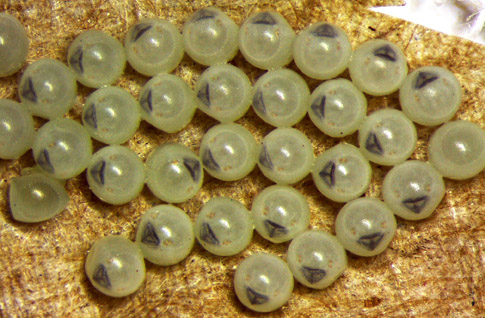
Source: Tara Gariepy, Agriculture and Agri-Food Canada.
First instar nymphs
First instar nymphs:
- are 2.4 mm
- have an orange abdomen with dark markings
- have a black head and legs
- remain clustered around egg mass
It is difficult to distinguish this life stage from other similar-looking species.
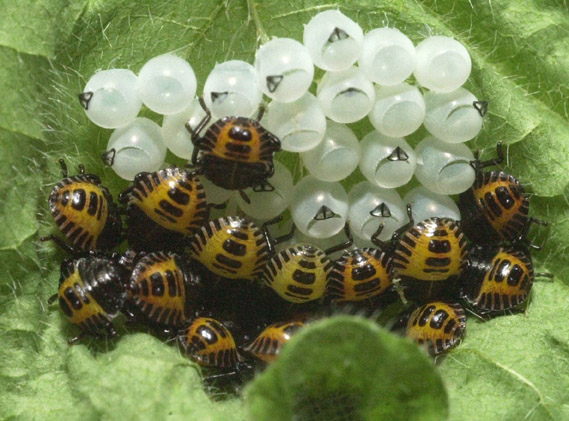
Source: David R. Lance, United States Department of Agriculture, Animal and Plant Health Inspection Service, Plant Protection and Quarantine, Bugwood.org.
Second instar nymphs
Second instar nymphs:
- are 3.7 mm
- are primarily black with yellowish red abdomen
- have a single faint white band on each antennae
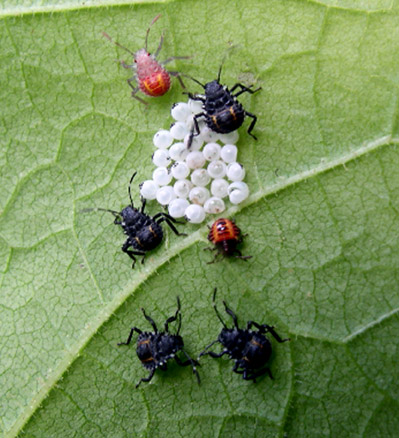
Source: Gary Bernon, United States Department of Agriculture, Animal and Plant Health Inspection Service, Bugwood.org.
Third to fifth instar nymphs
Third to fifth instar nymphs:
- are 5.5 to 12 mm
- become darker with maturity
- possess features similar to adults including:
- alternating light-dark pattern on edge of abdomen beginning to develop
- white bands on antennae
- obvious white bands on legs
- pronotum has prominent spines (Figure 4)
- wing pads in 5th instar nymph (Figure 5)
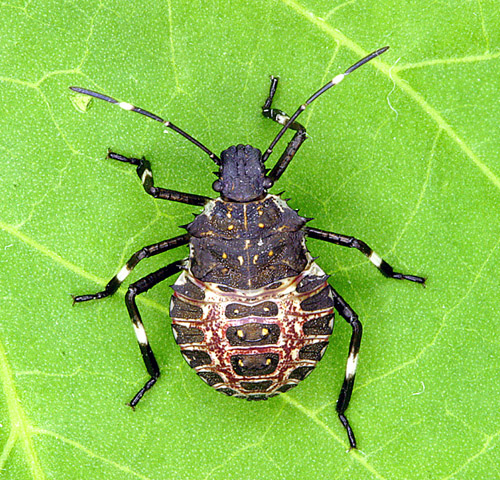
Source: Deepak Matadha, Rutgers University.
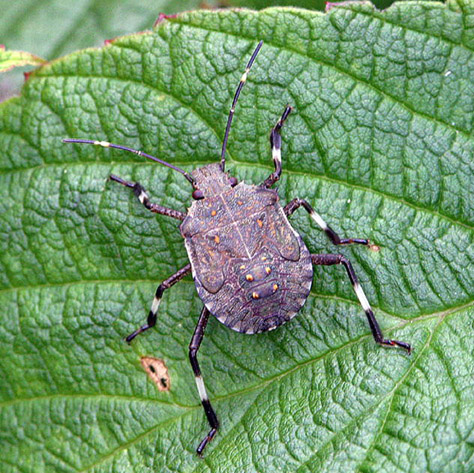
Source: Gary Bernon, United States Department of Agriculture, Animal and Plant Health Inspection Service, Bugwood.org.
Adults
Adults:
- are 14 to 17 mm long × 8 mm wide
- are marbled brown dorsally and pale ventrally
- have forewings with a distinct pinkish tinge when spread
- have abdominal margins that extend past their wings
- have white inward pointing triangles alternating with dark areas
- have legs with a poorly defined white band
- have smooth pronotum ("shoulders"), lacking spines except for one beside each eye
- have 2 white bands on antennae that are diagnostic for BMSB (last antennal segment is white basally and the second last segment is white both apically and basally)
BMSB adults may be confused with rough stink bugs (Brochymena spp.) and brown stink bugs (Euschistus spp.). However, both rough and brown stink bugs lack the 2 white bands on the antennae and have toothed edges on the pronotum (heavily toothed in rough stink bugs) (Figure 6, 7 and 8).
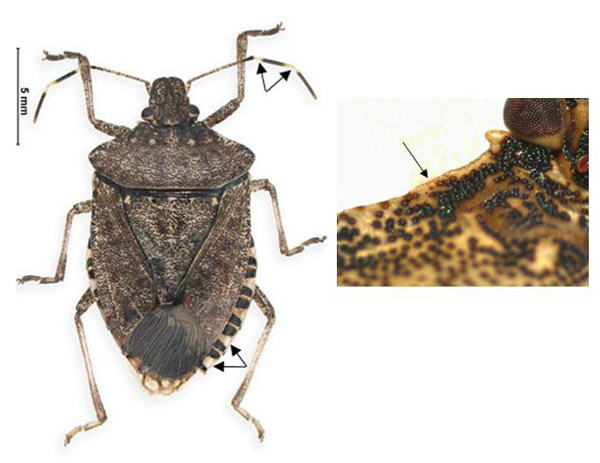
Source: Jennifer Read, Natural Resources Canada (left).
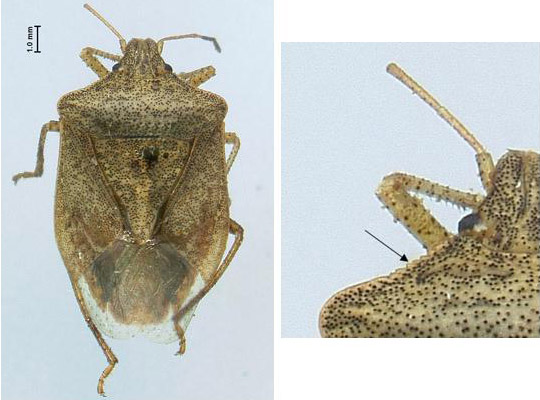
Source: Antonia Guidotti, Royal Ontario Museum.
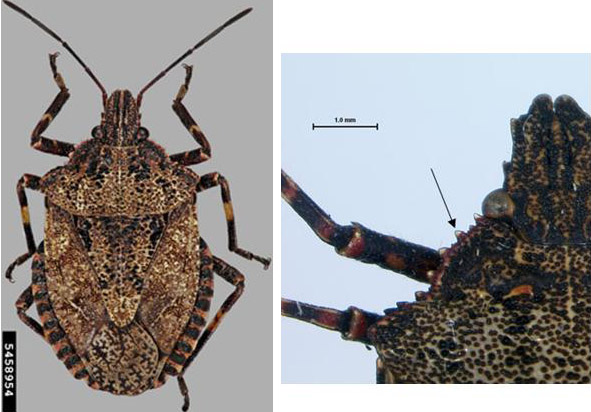
Source: Steven Valley, Oregon Department of Agriculture, Bugwood.org (left) and A. Guidotti, Royal Ontario Museum (right).
Biology
BMSB has a single generation per year in northern latitudes, though more are possible in warmer climates. Adults overwinter in human-made structures (such as homes and woodpiles). In areas where the pest is established and where hosts are abundant, BMSB can become a major nuisance pest due to large aggregations found indoors through the fall and winter. Within the natural landscape, they overwinter in large standing dead trees. Populations tend to become established in urban areas first then spread out to nearby agricultural crops.
Adults emerge in May through June as temperatures and day length increase. Females overwinter with undeveloped ovaries and must feed for 1 to 2 weeks prior to mating. Once mated, females lay numerous egg masses (about 28 eggs each) until late July or early August. Emergence from overwintering sites and egg-laying are staggered, resulting in the presence of multiple life stages throughout most of the growing season. Decreasing day length in August and September triggers movement of new adults to overwintering sites.
BMSB is well-adapted to a diversity of landscapes and does not require a specific host to facilitate establishment or spread. Patterns of dispersal between hosts during the season are not well understood and contribute to difficulties in management. The pest is highly mobile and can readily switch hosts, moving between crops throughout the growing season. Crops are at the greatest risk for injury when fruit, pods or seeds are present. Populations may build up on unmanaged woody hosts before moving into crops.
Damage
BMSB has a very broad host range that includes tree fruit, berries, grapes, vegetables, agronomic crops, ornamental trees and ornamental shrubs. Both nymphs and adults can cause injury. Damage results when nymphs and adults insert their piercing-sucking mouthparts into fruit, seedpods, buds, leaves or stems of plants. Digestive enzymes inserted into the plant result in the formation of small necrotic areas at the feeding site.
Symptoms of stink bug feeding can include:
- discoloured, deformed or corky fruit
- abscission or collapse of berries
- death of buds
- leaf stippling
- missing, shrivelled or stained seeds
- punctured kernels
- delayed maturity (green stem syndrome in soybeans)
- sap flow and discoloured bark in trees
Contamination at harvest is a concern for machine-harvested crops. Harvest of field crops may induce migration into late season crops, such as pome fruit and grapes. Crops bordering woodlots are at the highest risk of attack.
Management
Indoors
Mechanical exclusion is the most effective way to prevent BMSB from entering structures. Seal all cracks, repair or replace damaged screens and remove or cover window-mounted air conditioners prior to the fall. Live or dead stink bugs that have made their way indoors can be removed using a vacuum cleaner or shop vac (promptly dispose of vacuum bags or contents as the odour will persist). BMSB do not bite and they do not reproduce inside structures. The use of insecticides is not recommended.
Outdoors
While BMSB is established in urban areas, infestations have not been detected in crops in Ontario. There are several insecticides registered for use against BMSB in Canada, however action thresholds are not available for most crops. Management strategies are under development.